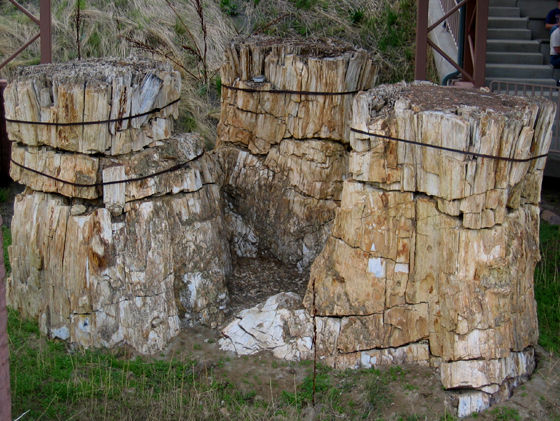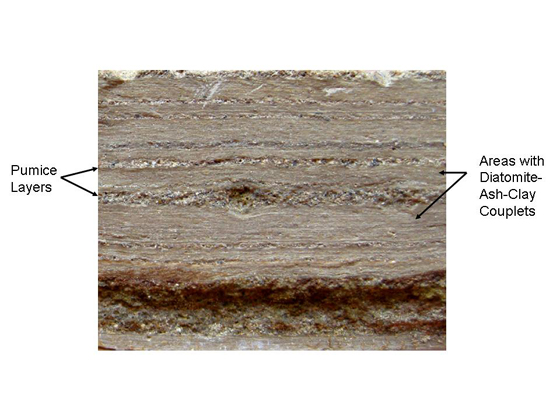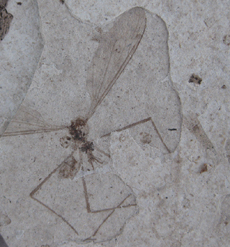
 |
 |
Florissant
Fossil Beds National Monument
Florissant,
Colorado: Fossils |
|
Fossil Forming Environments at Florissant Very different volcanic deposits preserved Eocene age life at Florissant. A destructive lahar provided a geologic environment in which wood became permineralized with silica. The petrified wood at Florissant is found in the lahar at the top of the mudstone. Although rare, fossil leaf impressions and compressions can be found in some parts of the mudstone. The delicate structures of leaves and insects are more commonly found in the shale units deposited within a lake environment. Preservation in the Lower Mudstone Unit During the late Eocene a lahar or volcanic mudflow from the Guffey volcano entombed redwood trees growing in the lower Florissant valley. The volcanic material that ended the life of these trees would also help to preserve them in stone. Portions of trees encased within the mudflow were permeated with groundwater carrying dissolved silica from the volcano, eventually forming petrified wood. Mustoe (2008) concluded that petrification at Florissant occurred in several stages. First, amorphous silica precipitated on cell wall surfaces of the wood. Second, opal-CT and chalcedony filled cell lumina (cell spaces). Finally, chalcedony filled fractures that crosscut permineralized tissues in some specimens. Spaces between adjacent tracheids in the Sequoioxylon were often unmineralized, making the fossil wood permeable to water and susceptible to cleaving radially, tangentially, and transversely from freeze-thaw weathering. This finding has important implications for the preservation of specimens at Florissant Fossil Beds National Monument (p. 127). Fossil
trees in the main Petrified Forest represent Sequoioxylon,
which is
a name for fossil wood closely related to the Sequoia growing along the coast of present day California. The largest
stump has a diameter of 4.1 m when measured at breast height
(1.5 m) above the ground. This size suggests a canopy height
of 60 m. We can infer from the preserved annual rings that
these redwoods were fast growing reaching diameters of 3 m
within 500 to 700 years (MacGinitie, 1953, p. 21). Fossil Sequoioxylon
pearsallii from Florissant has a higher mean ring width when
compared with the modern coast redwood (Sequoia sempervirens)
and the giant sequoia (Sequoiadendron giganteum), indicating
more favorable growing conditions for the fossil trees. Two
of the fossil stumps have been cross-dated, which demonstrates
they grew in a single forest (Gregory-Wodzicki, 2001, p. 163).
Three interconnected stumps (known as the “Redwood Trio”)
share a root system and represent a clone. These
characteristics are very much like what is seen in present
day forests of Sequoia trees (Nudds & Selden, 2008, p.
214). |
|
 Sequoioxylon pearsalli “Trio” |
|
Chadronoxylon, an angiosperm dicot, is also present among the Sequoioxylon stumps. Chadronoxylon florissantensis, the most abundant angiosperm wood at Florsissant, is a diffuse porous wood with affinities to the families Salicaceae (willows) and Phyllanthaceae (Wheeler and Meyer, 2012, p.9). Four additional angiosperm woods occur in the lower mudstone unit, but not in the main Petrified Forest. Interestingly, these woods are ring porous, indicative of seasonal environments. Two of the ring porous woods share characteristics with the elm family Ulmaceae and resemble Zelkova. A fourth resembles Koelreuteria of the soapberry family Sapindaceae. A fifth specimen is the first reported occurrence of a Hovenia like wood, from the buckthorn family (Rhamanaceae), in North America (Wheeler and Meyer, 2012, p.1). Zelkova, Koelreuteria, and Hovenia genera are restricted to East Asia today. The occurrence of these fossil woods at Florissant is evidence of Tertiary exchange between East Asia and North America. A sixth, Robinia-like wood (black locust) of the family Fabaceae was found in the caprock conglomerate (Wheeler, 2001, p. 187). One wonders what other wood types may have been present before the area was subjected to scavenging by souvenir collectors between the 1870s and 1969. The lower mudstone unit has also produced evidence of mammals including rodents, lagomorphs, insectivores, and ungulates. Oreotalpa florissantensis is the oldest known occurrence of a fossil mole (Family Talpidae) in North America (Lloyd and Eberle, 2008, p. 539). Several even-toed ungulates including the oreodont Merycoidodon and the deer-like Leptomeryx are represented at Florissant. Two odd-toed ungulates Mesohippus, a three-toed collie-sized horse, and a species of Megacerops, a large brontothere were also a part of the Florissant fauna. The Florissant mammalian fauna indicates a Chadronian or latest Eocene age for the Florissant Formation (Lloyd, Worley-Georg & Eberle, 2008, pp. 122 & 123; Prothero and Sanchez, 2004, p. 146). Preservation in the Shale Units
|
|
 Cross-Section of Paper Shale from Lower Shale Unit (1.8 cm thick) |
|
Both insects and leaves preserved in the Florissant beds are often carbonized. Insects and leaves entangled in the diatom mucus mats were incorporated into layers of sediments and volcanic ash at the bottom of Lake Florissant. Many of these insects and leaves decomposed leaving imprints. As the sediments compacted and hardened into shale the imprints became impression fossils. Some organisms only partially decayed retaining a dark colored carbon residue to become compression fossils (carbonization). Many insects have their wings preserved as impressions (no organic residue) while their bodies retain organic residue forming dark compressions. Compressions are often flattened, having a two-dimensional appearance. However, the preservation in diatom layers allows some organisms to retain their three-dimensional character. Some insects are found with organs and appendages. Some leaves can be found with internal structures (Meyer, 2003, pp. 35-37). |
|
 Fagopsis Lower Shale Unit |
 Crane Fly Lower Shale Unit |
Palynology, the study of microscopic plant fossils, such as pollen and spores, adds another 25 genera to the fossil flora of Florissant (Leopold & Clay-Poole, 2001, p. 17). Over 1500 of the 1700 described species at Florissant are insects and spiders (Meyer et al., 2004, p. 158). The most common vertebrate found in the fossil shale are fish, with the majority representing bottom dwellers. Four genera representing catfish, suckers, a bowfin and a pirate perch have been described. Although rare, birds are represented by a small plover, roller, and cuckoo. Only one mammal, a small opossum, has been found within the shale beds. Interestingly, no amphibians or reptiles have been found at Florissant (Nudds & Shelden, 2008, pp. 227 & 228). It is clear that the fossil bearing shale at Florissant has received a lot of attention from paleontologists over the years. However, within the shale units different depositional environments are also represented by layers of mudstone and siltstone. A recent study comparing shale, mudstone, and siltstone within the middle shale unit at Florissant found that the abundance and preservation quality of the most commonly found insect orders in lacustrine settings did not differ across these different sedimentary environments (Henning, Smith, Nufio, and Meyer, 2012, p. 481). The findings of this study are surprising for a couple of reasons.
Diatoms have been thought to play a major role in the preservation
quality of insects found within the shale. However, mudstone
is not typically associated with diatom layers indicating that
the presence of diatoms may not enhance preservation (Henning
et al., 2012, p. 487). Siltstone represents a higher energy depositional
environment with larger grain sizes than mudstone or shale. Interestingly,
the preservation quality and abundance of fossils found within
the siltstone was equal to mudstone and shale. Perhaps the paper
shale has been favored over the years because it is easier to
split open. The surprising results of this study suggest paleontologists
broaden their search for fossils by including the mudstone and
siltstone layers found within the shale units at Florissant. |
|
Bibliography |
|
| Gregory-Wodzicki,
K. M. (2001). Paleoclimatic Implications of Tree-Ring
Growth Characteristics of 34.1 Ma Sequoioxylon
pearsallii from Florissant, Colorado. In Evanoff,
E.,
Gregory-Wodzicki K.M. and Johnson, K.R. [Eds.] Fossil Flora and Stratigraphy
of the Florissant Formation, Colorado. (pp. 163-186). Proceedings of the
Denver Museum of Nature and Science, series 4, number 1. Henning, J.T., Smith, D.M., Nufio, C.R. and Meyer, H.W. (2012). Depositional setting and fossil insect preservation: a study of the late Eocene Florissant Formation, Colorado. Palaios 27: 481-488. Leopold, E.B. and Clay-Poole, S.T. (2001). Fossil leaf and pollen floras of Colorado compared: climatic implications. In Evanoff, E., Gregory-Wodzicki K.M. and Johnson, K.R. [Eds.] Fossil Flora and Stratigraphy of the Florissant Formation, Colorado. (pp. 17-55). Proceedings of the Denver Museum of Nature and Science, series 4, number 1. Lloyd, K. J., Worley-Georg, M.P., and Eberle J.J. (2008). The Chadronian mammalian fauna of the Florissant Formation, Florissant Fossil Beds National Monument, Colorado. In Meyer H.W. and Smith, D.M. [Eds.] Paleontology of the Upper Eocene Florissant Formation, Colorado. (pp. 117-126). The Geological Society of America, Special Paper 435. Lloyd, K.J., and Eberle, J.J. (2008). A new talpid from the late Eocene of North America. Acta Palaeontologica Polonica 53 (3): 539-543. MacGinitie, H.D. (1953). Fossil Plants of the Florissant Beds, Colorado. Washington, D.C.: Carnegie Institution of Washington Publication 599. Manchester, S.R., (2001). Update on the megafossil flora of Florissant, Colorado. In Evanoff, E., Gregory-Wodzicki K.M. and Johnson, K.R. [Eds.] Fossil Flora and Stratigraphy of the Florissant Formation, Colorado. (pp. 137-161). Proceedings of the Denver Museum of Nature and Science, series 4, number 1. Meyer, H.W. (2003). The Fossils of Florissant. Washington: Smithsonian Books. Meyer, H.W., Veatch, S.W. and Cook, A. (2004). Field guide to the paleontology and volcanic setting of Florissant fossil beds, Colorado (pp. 151-166). In Nelson, E.P. and Erslev, E.A. [Eds.] Field Trips in the Southern Rocky Mountains, USA. Geological Society of America Field Guide 5. Mustoe, G.E. (2008). Mineralogy and geochemistry of late Eocene silicified wood from Florissant Fossil Beds National Monument, Colorado. In Meyer, H.W., and Smith, D.M., [Eds.], Paleontology of the Upper Eocene Florissant Formation, Colorado (pp. 127-140). Geological Society of America Special Paper 435. O’Brien, N.R., Meyer, H.W., Reilly, K., Ross, A.M., and Maguire, S., (2002). Microbial taphonomic processes in the fossilization of insects and plants in the late Eocene Florissant Formation, Colorado: Rocky Mountain Geology, v. 17, pp. 1-11). Nudds, J.R. & Selden, P.A. (2008). Fossil Ecosystems of North America: A Guide to the Sites and Their Extraordinary Biotas. Chicago: The University of Chicago Press. Prothero, D.R. and Sanchez, F., (2004). Magnetic stratigraphy of the upper Eocene Florissant Formation, Teller County, Colorado. In Lucas, S.G., Zeigler, K.E., and Kondrashov, P.E. [Eds.]. Paleogene Mammals. (pp. 129-135). New Mexico Museum of Natural History and Science Bulletin 26. Wheeler E.A. (2001). Fossil Dicotyledonous Woods from Florissant Fossil Beds National Monument, Colorado. In Evanoff, E., Gregory-Wodzicki K.M. and Johnson, K.R. [Eds.] Fossil Flora and Stratigraphy of the Florissant Formation, Colorado. (pp. 1-16). Proceedings of the Denver Museum of Nature and Science, series 4, number 1. Wheeler E.A. and Meyer, H.W. (2012). A new (Hovenia) and an old (Chadronoxylon) fossil wood from the late Eocene Florissant Formation, Colorado, U.S.A. IAWA Journal, 33(3) –001-010. |
|










